The Short Version
- From Southdale Center in 1956 to today’s reinvented centers, malls continue to serve as places to gather, shop and connect.
- Early features like food, services, public art and social spaces remain central to successful malls.
- Fashion and specialty stores made malls cultural icons in the 1980s and ’90s, a role now echoed by digitally native brands.
- Gen Z’s embrace of malls underscores their enduring role as community and cultural hubs.
Malls Have Changed With the Times, but Their Community Role Remains Constant
Consumer demand has evolved since 1956 when the Dayton family opened Edina, Minnesota’s Southdale Center, credited as the first fully enclosed mall in the U.S. Yet the core appeal of the mall format has endured: a safe, convenient place to gather, shop and connect. As both traditional and reinvented malls make headlines today for surging sales and traffic, C+CT asked industry leaders to reflect on how these properties have changed — and on the timeless ways they continue to serve their communities.
Postwar Suburbs Needed a Hub — Malls Delivered
The era of enclosed malls started with the postwar suburban boom. Even though the population shift to the suburbs was still in its early days at the time, concerns about isolation and sprawl already had emerged by the mid-1950s. In designing Southdale Center, architect Victor Gruen aimed to create an environment that would allow people to “get out of their cars and interact with each other” in a setting that was “flooded with daylight, filled with public art and housed ‘sidewalk’ cafes,” reads a project description by Gruen Associates.
Known as the pioneer of modern mall design, Gruen’s vision for these public places “was for a less car-centric shopping and living environment,” noted a U.S. Library of Congress research guide on Southdale Center. “They would be a place people could go, park and once there, could wander, shop, eat, do errands and socialize without worrying about crossing streets and continually driving store to store.”
The idea took off, in part because newly minted suburbanites lived too far from city centers to make daily shopping trips to downtown department stores like Rich’s in Atlanta, Wanamaker’s in Philadelphia, Filene’s in Boston or Marshall Field’s in Chicago. “As the suburbs grew, the American public wanted a place to go to be able to see other people, socialize and shop with some efficiency and pleasure,” said Paco Underhill, founder of retail consultancy Envirosell and author of the 2005 book “Call of the Mall,” noting that “as that happened, part of what we saw here in the United States was an explosive growth of malls.”
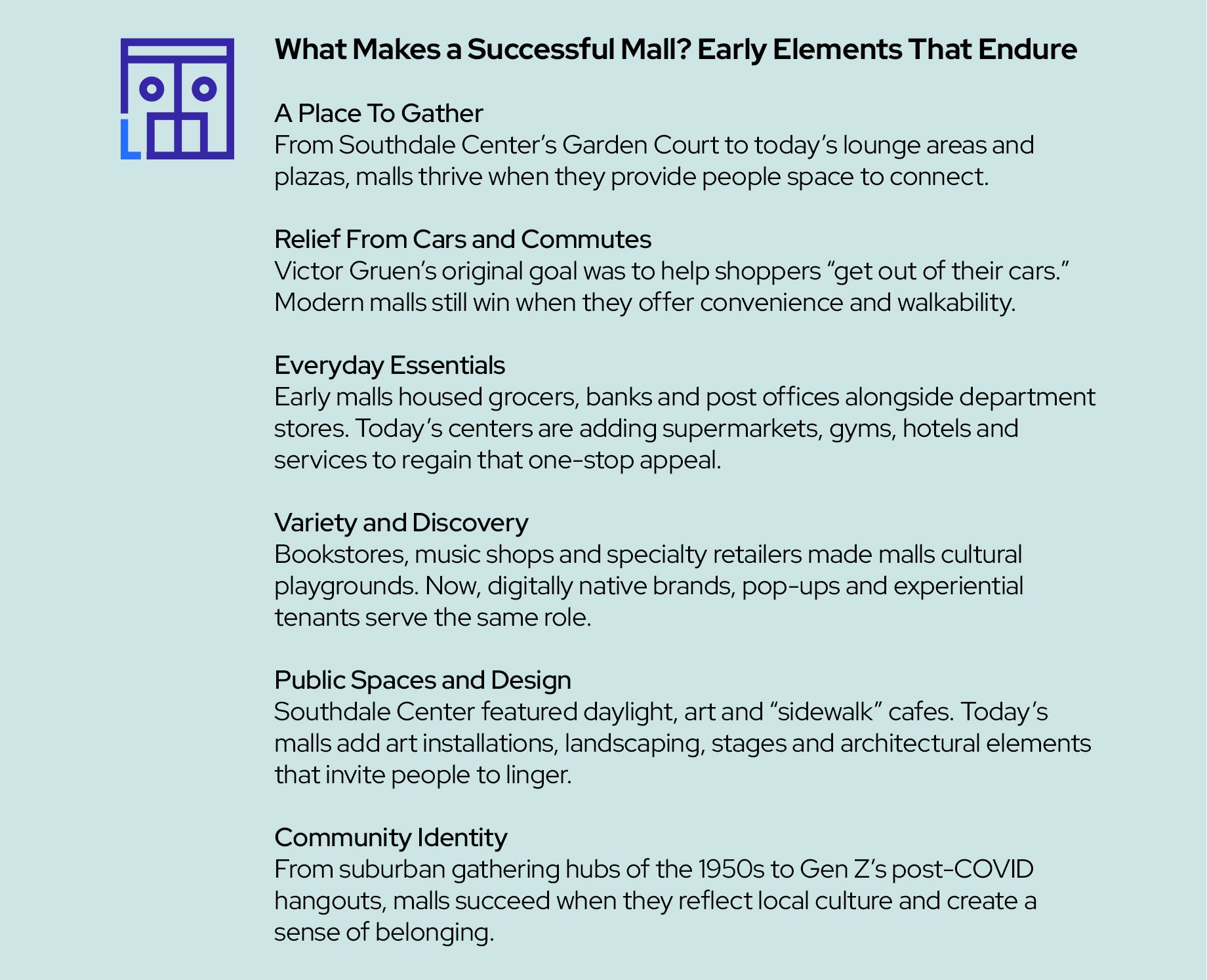
Southdale’s Early Mix: Department Stores, a Grocer and Everyday Services
Southdale Center’s 72 stores and service tenants offered uses that were common to 1950s downtowns, including department stores Dayton’s and Donaldson’s, a Red Owl grocer, a bank, a barber and a post office. The new multitenant malls were beginning to operate more like single properties by the end of the decade, aided by the arrival of reciprocal easement agreements and more sophisticated and standardized lease clauses. Rising popularity also meant that enclosed malls could keep growing. By ICSC’s account, the first superregional center — the 2 million-square-foot Woodfield Mall in Schaumburg, Illinois — opened in 1971.
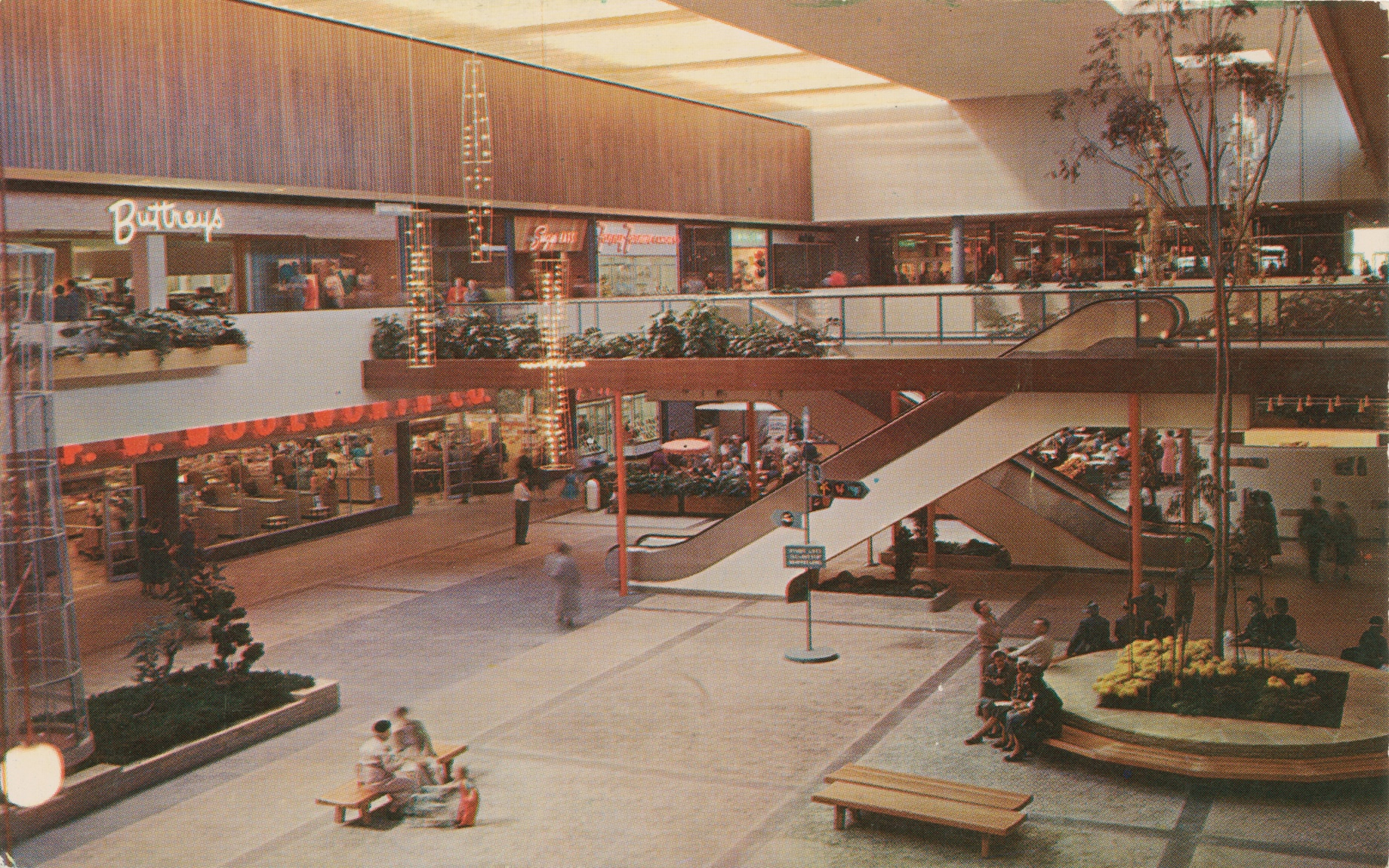
Southdale Center in Edina, Minnesota, which opened in 1956 and now is owned by Simon, is widely considered the original prototype for the enclosed mall. Above is the mall’s Garden Court circa 1965. Photo above and at top courtesy of the Minnesota Historical Society
Department Stores Versus Grocers and Drugstores in Early Malls
Anchors like Macy’s, Sears, JCPenney, Montgomery Ward and Nordstrom came to wield more leverage, weaving in tough restrictions to their multidecade leases and REAs. “In the 1980s, if you were building a mall in Sioux City, Iowa, and could get a deal for a Macy’s or even Sears, this helped you get the money from banks to build the property,” Underhill explained. “But the department stores back then did not want shopping carts in the mall. They would say: ‘I will be happy to sign your lease, but I do not want either drugstores or supermarkets as possible co-tenants.’”
The resulting tenant mixes made for incomplete shopping solutions, Underhill said, requiring suburbanites to add separate stops for groceries and other daily needs.
Apparel and Specialty Retail Turned Malls Into Cultural Phenomena in the 1980s and ’90s
Into the 1980s and ’90s, tenants like Macy’s, The Limited, Benetton, Esprit, Merry-Go-Round, Casual Corner and Payless ShoeSource made enclosed malls the go-to places to buy apparel and accessories. Specialty operators like Waldenbooks, Kay-Bee Toys, Sam Goody, Glamour Shots, RadioShack, Spencer’s, Wicks ‘N’ Sticks, Victoria’s Secret and Bath & Body Works became cultural touchpoints in their own right.
But intense competition was on the way. Walmart opened its first Sam’s Clubs and Walmart Supercenters in the 1980s. By 1992, the company had grown to employ 371,000 people in 1,928 stores and clubs. Wal-Mart Stores Inc. marked its first $1 billion sales week in 1993, according to the company.
Big-Box Retail and Open-Air Centers Diverted Shoppers From Malls
The trend toward big-box retail spurred developers to favor open-air power centers over enclosed malls. These properties could be as large as 700,000 square feet, anchored by large-format specialty retailers like The Home Depot, Staples, Best Buy or Toys R Us. “The category killers were taking the merchandise that you used to go to the department store for but offering much, much deeper inventory selection and probably better pricing,” said Richard Latella, executive managing director and retail practice group co-leader for Cushman & Wakefield’s valuation and advisory group. “They started taking more market share from full-service department stores.”
From Black Monday to the Great Recession, Shoppers Grew Price-Savvy
Economic shocks in the ’80s led to signs of trouble for the mall sector, noted Cushman & Wakefield president of Americas retail services Barrie Scardina. She recalled working at a high-end women’s apparel store in the days after Oct. 19, 1987, known as Black Monday, when the Dow Jones Industrial Average fell by 22.6% in a single day. “Suddenly people were coming back and returning their merchandise because of the impending financial crisis,” Scardina said. “In the late 1980s, you started to see mall-sector consolidation and survival of the fittest for the first time.”
Toward the end of the ’90s, mall retailers needed to adapt to emerging e-commerce competition, as well, and department stores were lagging, Latella noted. “I have a list of hundreds of names of department stores that have either gone away or morphed into another name like Macy’s,” Latella said. The Global Financial Crisis of 2008 then triggered a margin-eroding inventory mismatch as mall shoppers came to expect perpetually steep discounts, Scardina added. “Retailers found themselves in a very difficult financial period. They needed to shed inventory, and that created a tremendous promotional cycle which lasted for years: earlier openings on Black Friday, longer hours for sales, more and more discounts.”
Particularly in the years stretching from the Great Recession in the late 2000s to just after the COVID lockdowns, many malls worked to adapt to changing shopper needs. “They had lost their way,” Scardina said. “When you’re playing defense, it’s hard to be strategic and thoughtful.”
Today’s Malls Still Serve as Community Gathering Places
At the best of today’s 1,100 malls, momentum reflects not only consumer trends like the heightened interest in food and the surge of digitally native brands opening brick-and-mortar stores but also the adaptive strategies of mall owners and leasing teams, sources said.
In many ways, malls are reprising roles that go back to their earliest days. After World War II, for example, the then-new centers gave Americans an escape from the isolation of suburban life. Likewise, shoppers in the post-pandemic era have flocked to malls to recapture the social, shopping and dining experiences they missed during COVID lockdowns. That same impulse for gathering together helps explain why Gen Z, in particular, is so keen on malls.
In many ways, malls are reprising roles that go back to their earliest days.
How Mall Owners Are Reinventing Space for Modern Shoppers
Now, owners like Brookfield Properties, Simon, Macerich and CBL are repurposing mall space in ways that meet people’s evolving needs.
MORE FROM C+CT: CBL CEO Stephen Lebovitz Says “The Mall Is Relevant Again”
After Macy’s went dark at luxury center Tysons Galleria in 2019, Brookfield redesigned and subdivided the three-level, 260,000-square-foot anchor space. It’s now home to tenants like RH, Crate & Barrel, Lucid Motors, Arhaus, Lucky Strike, CMX CinéBistro and Lady M cake boutique. The landlord also added an indoor hangout area and an outdoor streetscape.
During the original mall boom, cookie-cutter lineups were commonplace, and multibrand owners like Gap Inc. and The Limited Inc. played an outsize role. “It was The Limited, Express, Lane Bryant, Gap, Gap Kids, Gap Baby,” Scardina said. “You could have 10 stores that really represented two brands.” Today’s mall owners strive for creative mixes tailored closely to community needs, said Brookfield retail president Jonathan Kramer. “Listening and understanding what the need is, then leaning into that with the right retailers is the way to create a product or overall center that speaks to people,” he said. “It has been really important to the evolution of the mall.”
FROM THE C+CT ARCHIVE: Malls Aren’t Going Extinct. They’re Adapting and The Road Maps (Plural) for Reinventing Enclosed Malls
The strategy is visible at Brookfield’s Stonestown Galleria in San Francisco, the recent success of which has drawn national attention, Kramer said. Redeveloped in 2023, the 90-tenant mall features national retailers while also catering to niche audiences — from tenants like Activate, Immersive Gamebox and Round1 Bowling & Arcade for experience seekers to specialty and dining concepts including Pop Mart, Candy Doll Beauty, Marugame Udon, Supreme Dumplings, Tang Bar, Uncle Tetsu, Wanpo Tea Shop and Kizuki Ramen, which resonate with San Francisco’s diverse Asian communities while drawing a wide range of shoppers.
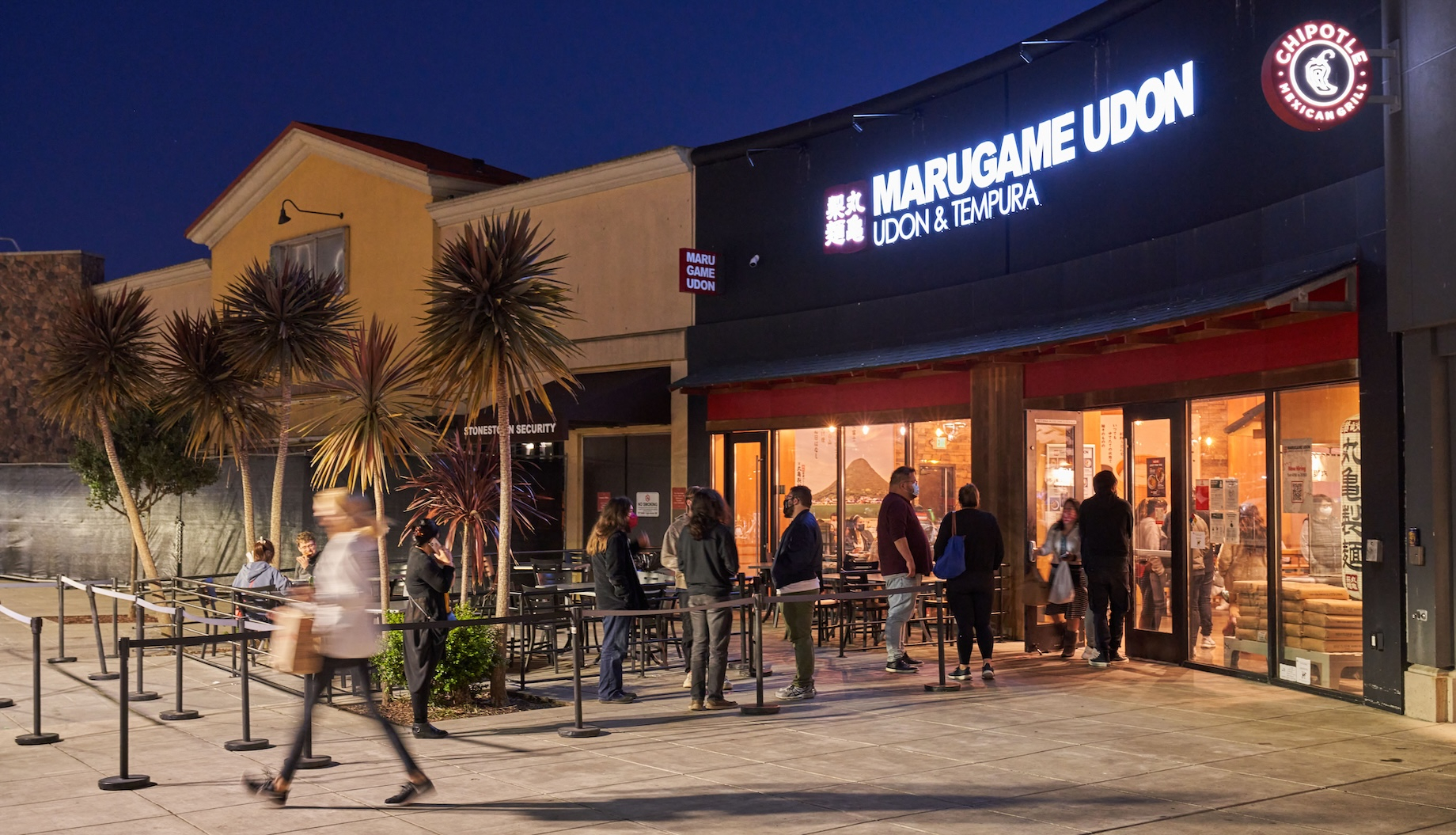
Marugame Udon is one of many Asian-themed tenants at San Francisco’s Stonestown Galleria. Photo courtesy of Brookfield Properties
Mixed-Use and Residential Give Malls New Life
In “Call of the Mall,” Underhill wrote that the creation of “neo-villages” was part of the original inspiration for malls. Today’s conversions of malls into mixed-use centers — with their streetscapes, open-air plazas, green spaces, outdoor cafes, office towers, apartments, hotels and the like — represent the next step in that evolution.
Mixed-use reinventions meet a broader array of needs, from the desire to avoid time-wasting commutes to the hunger for livelier workplace surroundings. They also appeal to multiple generations, Underhill noted. “If you live in Minneapolis and you are about to retire, you might say: ‘I am tired of shoveling snow. I could move to Phoenix or Scottsdale, but then how would I see my grandchildren?’ The shopping mall needs to fit into how housing choices are being made.”
MORE FROM C+CT: How Retail and Multifamily Work Together
Kramer points to residential components at the 1.1 million-square-foot Alderwood in the Seattle suburb of Lynnwood. After the 46-year-old mall’s Sears shuttered in 2019, Brookfield replaced the vacant anchor with Avalon Alderwood Place, a 328-unit apartment complex. Served by light-rail, the mall has 130 retail, dining and entertainment tenants, including Nordstrom, Zara, Aerie, H&M, Dave & Buster’s, Fogo de Chão and Altar’d State. A Fred Meyer supermarket is just offsite. “I’m told that the demand to live at the apartments inside the mall is greater than for the multifamily buildings that sit just outside of the ring road,” Kramer said. “It is its own community, just being at the mall. There has been huge demand for this.”
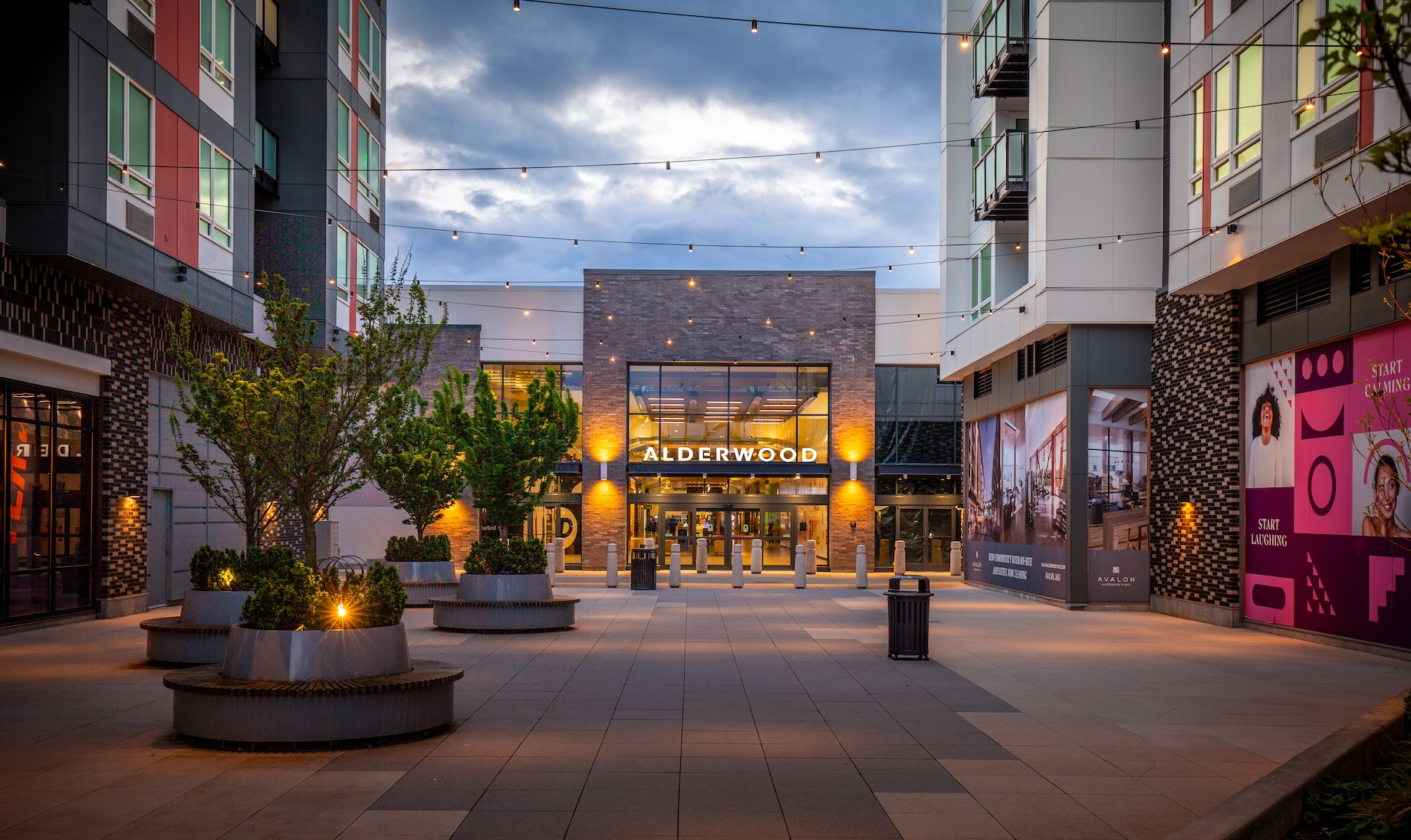
Replacing Sears with residential added a live-work-play dimension to Alderwood in Seattle, a trend that has enlivened malls across the country in recent years. Photo courtesy of Brookfield Properties
At the 900,000-square-foot Cumberland Mall in the Atlanta suburbs, Brookfield redeveloped a former Sears Auto building to bring in 327 residential units. Separately, it redeveloped a former Sears department store box and added tenants like Golf Galaxy, Planet Fitness and Round1 Bowling & Arcade. “There is definitely a diversification of uses at today’s malls that was not there traditionally,” Kramer said.
The approach has come full circle to Southdale Center itself. The Simon-owned property now boasts 232 apartments, a Kowalski’s Markets grocery store and a Homewood Suites by Hilton hotel.
A YEAR AGO IN C+CT: Residential Makes Up a Quarter of Simon’s $4 Billion Pipeline
That said, the expanding property still functions like a traditional mall. Its key tenants include Lululemon, J.Crew, State & Liberty, Aritzia and Reformation. Anchor spaces are occupied by Macy’s, Kowalski’s, AMC Theatres and a resort-style Life Time athletic complex with pickleball courts. A luxury wing with brands like Max Mara, Moncler and David Yurman opened this past June. Gucci, Louis Vuitton, Tiffany & Co. and Watches of Switzerland are set to arrive by the end of the year, according to a Simon spokesperson.
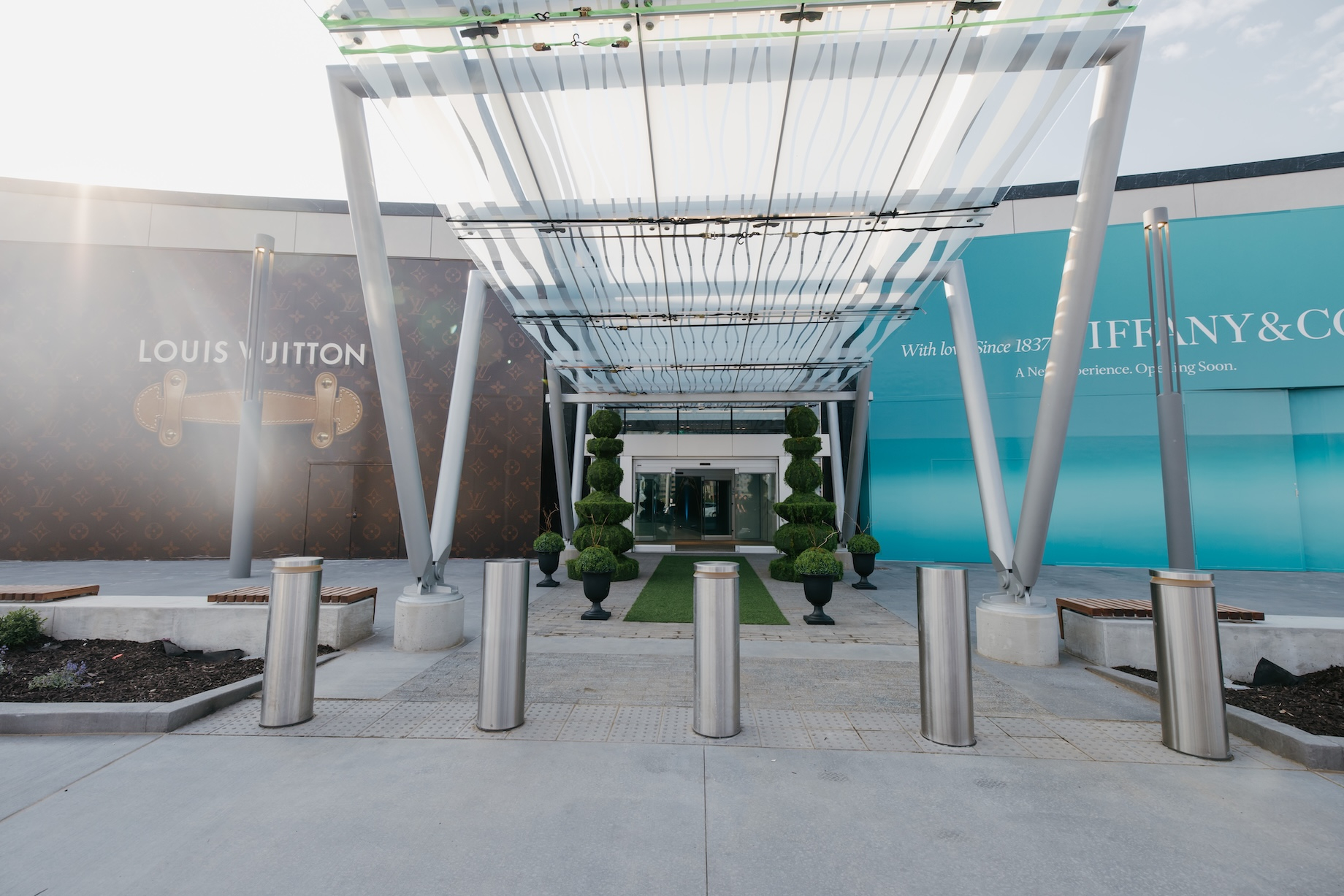
Simon opened a luxury wing this past June at Edina, Minnesota’s Southdale Center, which is credited as the first enclosed mall in the U.S. The property has continued to evolve and expand since its debut in 1956. Photo courtesy of Simon
Public Art and Design Connect Malls to Their Communities
Enclosed malls and their air conditioning were a novelty in the 1950s, but with time, shoppers started to long for something more than their fortress-like design, likened in “Call of the Mall” to a big wall with a little mousehole. “As they built malls in the ’70s, ’80s and ’90s, it was almost like you were taking the consumer and transferring them to a totally different, encapsulated environment,” Scardina noted. “Today, people want spaces that feel like a community, including engagement with nature and art. They want to have unique experiences with family and friends.”
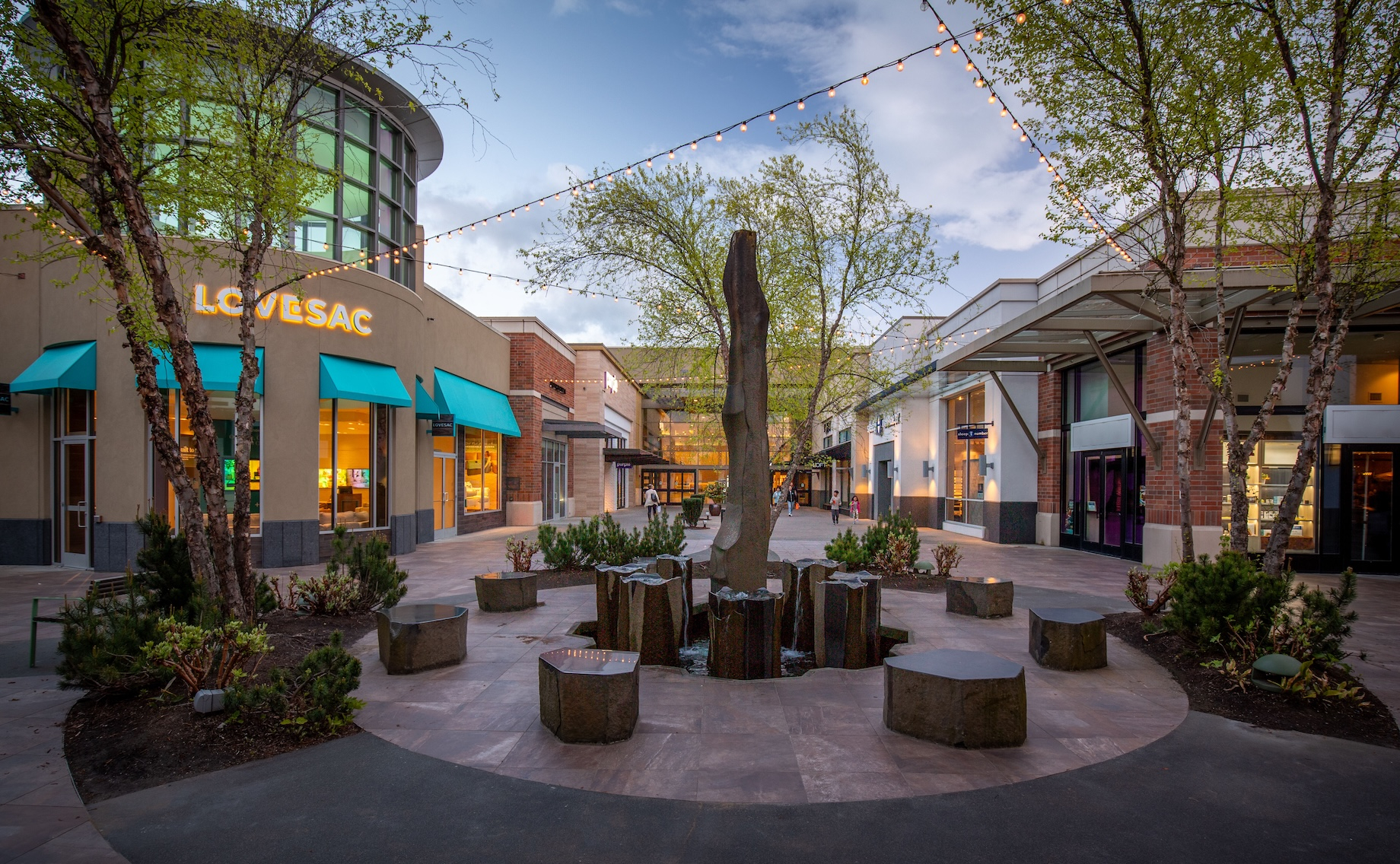
Mall owners continue to add gathering spots with outdoor seating areas, public art, greens paces, plazas, stages and the like. Above is a hangout space at Alderwood in Seattle. Photo courtesy of Brookfield Properties
As Latella sees it, the public green spaces, cafes, murals, entertainment stages and higher-end finishes found at reimagined malls speak to these needs. Nonetheless, he said, plenty of thriving malls look much the same as when they were built. That nostalgic look, in fact, can be part of the attraction for Gen Z, which has developed a taste for throwback mainstays like vinyl records, cassette tapes and film cameras.
FROM THE C+CT ARCHIVE: 42 Art Installations That Have Brought Shopping Centers to Life During the Pandemic
Gen Z’s penchant for malls echoes the “mall rats” of the ’80s but with the added layers of social media and mobile tech. In Kramer’s view, mall owners can cater to this analog-digital generation by blending trending retail and entertainment concepts along with Instagram- and TikTok-worthy public art, landscaping and design.
The executive points to liveliness added by distinctive visual elements like the giant cowboy boots sculpture at North Star mall in San Antonio. “They’re a way to give selfie-takers and mini-influencers the backgrounds they crave,” Kramer said. “At Fashion Show Las Vegas, we hosted an interactive pop-up called Selfie Studio that was incredibly popular, especially with younger visitors who love to share their mall experiences on social media.”
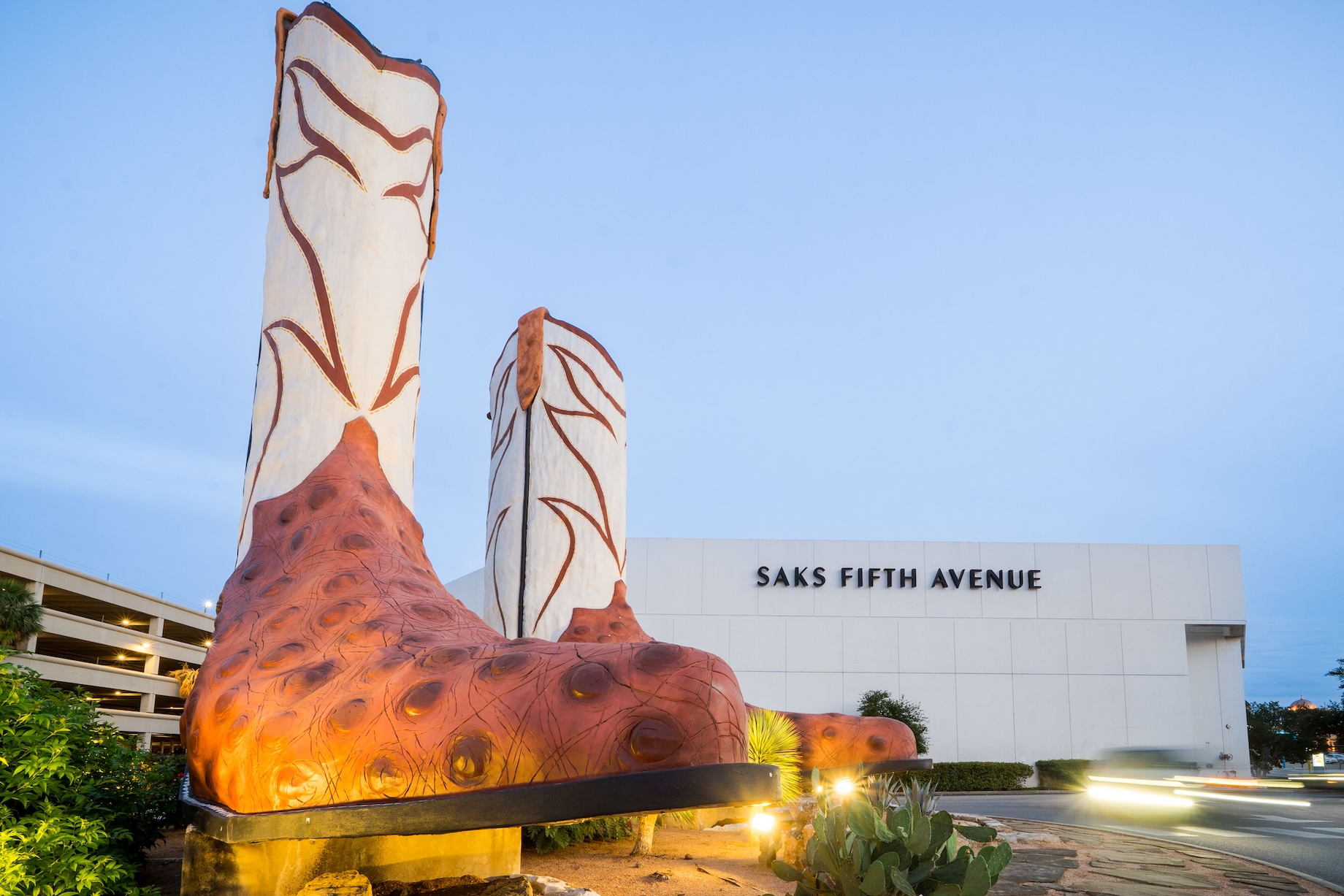
Selfie-friendly giant cowboy boots add color to Brookfield Properties’ North Star Mall in San Antonio. Photo courtesy of Brookfield Properties.
Gen Z Shapes the Future of Malls
Gen Z’s focus on in-person shopping creates more opportunities for malls. A 46-page report published in June — Gen Z Is Evolving: Their Search for Meaning, Connection, and the Brands That Get It — plumbs the topic. The two-year research project was conducted by MG2 Advisory, an arm of architecture and design firm MG2, and included a May 2025 survey of 1,008 Gen Zers in the U.S. Three out of five said they visited stores to experience community and feel a greater sense of belonging, according to co-author and MG2 Advisory principal and founder Melissa Gonzalez. “Gen Z values community,” she said, “so it’s key to understand what they want out of the communal experience and how malls can tap into culture, curate bespoke programming and design an environment that resonates as a social destination.”
Gonzalez encourages malls to create advisory boards that further zero in on the needs of Gen Z, who are ages 18 to 26, and Gen Alpha, the first generation born entirely in the 21st century. “Brands are good at launching these initiatives, plus it provides significant insights into the pulse of the generation. Malls can do this, too.”
MORE FROM ICSC: The Rise of the Gen Z Consumer
By Joel Groover
Contributor, Commerce + Communities Today